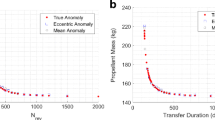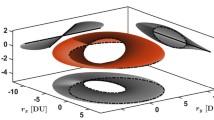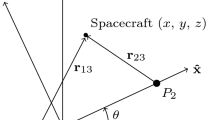Abstract
A time regularization scheme is introduced that facilitates trajectory optimization in multi-body regimes. The time transformation function allows for fixed-step propagation, while eliminating the need for multiple models in patched conic approaches, and mitigating the risk of step** over unplanned flybys. The scheme is motivated by Sundman’s two-body regularization, but accounts for multiple bodies using their spheres of influence and a Heaviside approximation. The transformation enables efficient discretization of the many types of motion that exist in multi-body regimes. The new formulation is analyzed in several restricted three-body dynamical problems, which serve as proxy models that capture the dominant features of N-body ephemeris models within the solar system. The parameters embedded in the transformation are tuned, and its performance is compared against several existing regularizations on a diverse set of examples including periodic orbits in the Earth–Moon and Saturn-Enceladus systems, a low-thrust Earth–Moon spiral, and a low-altitude Jupiter-Europa flyby. The transformation is shown to be robust to the differing conditions, outperforming the benchmarks over wide ranges of the tuning parameters. The results of the numerical experiments are used to justify a set of recommendations for parameter selection in general multi-body applications. The regularization is finally demonstrated on ephemeris-modeled Saturn system trajectories that include unplanned flybys and traverse all three levels of the sun-planet-moon solar system hierarchy.























Similar content being viewed by others
References
Cowell, P.: The orbit of jupiter’s eigth satellite. Mon. Not. R. Astron. Soc. 69(5), 421–431 (1909). https://doi.org/10.1093/mnras/69.5.421
Sundman, K.: Mémoire sur le probléme des trois corps. Acta Math. 36, 107–179 (1913). https://doi.org/10.1007/BF02422379
Levi-Civita, T.: Sur la régularisation du probleme des trois corps. Acta Math. 42, 99–144 (1920). https://doi.org/10.1007/BF02404404
Kustaanheimo, P., Stiefel, E.: Perturbation theory of Kepler motion based on spinor regularization. J. für die reine und angewandte Mathematik 218, 204–219 (1965). https://doi.org/10.1515/crll.1965.218.204
Stiefel, E., Scheifele, G.: Linear and Regular Celestial Mechanics. Springer-Verlag, New York (1971)
Aarseth, S., Zare, K.: A regularization of the three-body problem. Celest. Mech. 10(2), 185–205 (1974). https://doi.org/10.1007/BF01227619
Heggie, D.: A global regularization of the gravitational n-body problem. Celest. Mech. 10(2), 217–241 (1974). https://doi.org/10.1007/BF01227621
Zare, K., Szebehely, V.: Time transformations in the extended phase-space. Celest. Mech. 11, 469–482 (1975). https://doi.org/10.1007/BF01650285
Mikkola, S.: The intermediate anomaly. Celest. Mech. 16(3), 309–313 (1977). https://doi.org/10.1007/BF01232657
Belen’kii, I.: A method of regularizing the equations of motion in the central force-field. Celest. Mech. 23(1), 9–32 (1981). https://doi.org/10.1007/BF01228542
Cid, R., Ferrer, S., Elipe, A.: Regularization and linearization of the equations of motion in central force-fields. Celest. Mech. 31(1), 73–80 (1983). https://doi.org/10.1007/BF01272561
Ferrándiz, J., Ferrer, S., Sein-Echaluce, M.: Generalized elliptic anomalies. Celest. Mech. 40(3–4), 315–328 (1987). https://doi.org/10.1007/BF01235849
Peláez, J., Hedo, J., de Andrés, P.: A special perturbation method in orbital dynamics. Astron. J. 97, 131–150 (2007). https://doi.org/10.1007/s10569-006-9056-3
Urrutxua, H., Urrutxua, H., Peláez, J.: Dromo propagator revisited. Astron. J. 124(3), 1–31 (2016). https://doi.org/10.1007/s10569-015-9647-y
Deprit, A.: Ideal elements for perturbed Keplerian motions. J. Res. Nat. Bur. Stand. 79, 1–15 (1975)
Hansen, P.: Mémoire sur le calcul des perturbations qu’eprouvent les comètes. C. R. Acad. Sci. 1, 1–258 (1853)
Baù, G., Bombardelli, C.: Time elements for enhanced performance of the DROMO orbit propagator. Astron. J. 148(3), 43 (2014). https://doi.org/10.1088/0004-6256/148/3/43
Roa, J.: Regularization in Orbital Mechanics: Theory and Practice. De Gruyter, Berlin (2017)
Amato, D., Baù, G., Bombardelli, C.: Accurate orbit propagation in the presence of planetary close encounters. Mon. Not. R. Astron. Soc. 470(2), 2079–2099 (2017). https://doi.org/10.1093/mnras/stx1254
Sellamuthu, H., Sharma, R.K.: Hybrid orbit propagator for small spacecraft using kustaanheimo-stiefel elements. J. Spacecr. Rockets 55(5), 1282 (2018). https://doi.org/10.2514/1.A34076
Amato, D., Bombardelli, C., Bau, G., Morand, V., Rosengren, A.J.: Non-averaged regularized formulations as an alternative to semi-analytical orbit propagation methods. Celest. Mech. Dyn. Astron. 131(21), 1–38 (2019). https://doi.org/10.1007/s10569-019-9897-1
Sellamuthu, H., Sharma, R.K.: Regularized luni-solar gravity dynamics on resident space objects. Astrodynamics 5(2), 91–108 (2021). https://doi.org/10.1007/s42064-020-0085-6
Masat, A., Romano, M., Colombo, C.: Kustaanheimo-stiefel variables for planetary protection compliance analysis. J. Guid. Control Dyn. 45(7), 1286 (2022). https://doi.org/10.2514/1.G006255
Pellegrini, E., Russell, R.P.: On the computation and accuracy of trajectory state transition matrices. J. Guid. Control Dyn. 39(11), 2485 (2016). https://doi.org/10.2514/1.G001920
Czuchry, A.J., Pitkin, E.T.: Regularization vs step-size regulators in optimal trajectory computations. J. Spacecr. Rockets 7(7), 882–885 (1970). https://doi.org/10.2514/3.30062
Kohlhase, C., Penzo, P.: Voyager mission description. Space Sci. Rev. 21, 77–101 (1977). https://doi.org/10.1007/BF00200846
D’Amario, L., Bright, L., Wolf, A.: Galileo trajectory design. Space Sci. Rev. 60, 23–78 (1992). https://doi.org/10.1007/BF00216849
Bellerose, J., Roth, D., Criddle, K.: The cassini mission: reconstructing thirteen years of the most complex gravity-assist trajectory flown to date. In: Proceedings of the SpaceOps Conference. (2018). https://doi.org/10.2514/6.2018-2646
Wolf, A., Smith, J.: Design of the Cassini tour trajectory in the saturnian system. Control Eng. Pract. 3(11), 1611–1619 (1995). https://doi.org/10.1016/0967-0661(95)00172-Q
Buffington, B., Strange, N., Smith, J.: Overview of the cassini extended mission trajectory. In: AIAA/AAS Astrodynamics Specialist Conference. Portland, ME. (2019). https://doi.org/10.2514/6.2008-6752
Roth, D., Alwar, V., Bordi, J., Goodson, T., Hahn, Y., Ionasescu, R., Jones, J., Owen, W.M., Pojman, J., Roundhill, I., Santos, S., Strange, N., Wagner, S.V., Wong, M.: Cassini tour navigation strategy. Tech. Rep (2003)
Buffington, B.: Trajectory design concept for the proposed europa clipper mission. In: Proceedings of the AAS/AIAA Astrodynamics Specialist Conference. (2014). https://doi.org/10.2514/6.2014-4105
Szebehely, V.: Theory of Orbits. The Circular Restricted Three-Body Problem. Academic Press, Cambridge (1967)
Berry, M., Healy, L.: The generalized Sundman transformation for propagation of high-eccentricity elliptical orbits. In: Proceedings of the 12th AAS/AIAA Space Flight Mechanics Meeting vol. 112(11) (2002)
Pellegrini, E., Russell, R., Vittaldev, V.: F and g Taylor series solutions to the stark problem with Sundman transformations. Celest. Mech. Dyn. Astron. 118(4), 355–378 (2014). https://doi.org/10.1007/s10569-014-9538-7
Ottesen, D., Russell, R.P.: Piecewise Sundman transformation for spacecraft trajectory optimization using many embedded lambert problems. J. Spacecr. Rockets 59, 1–18 (2022). https://doi.org/10.2514/1.A35140
Yeomans, D.: Exposition of sundman’s regularization of the three-body problem. Tech. rep., NASA-TM-X-55636, X-640-66-481. NASA Goddard Space Flight Center Technical Report (1966)
Aarseth, S.: Gravitational N-Body Simulations: Tools and Algorithms. Cambridge University Press, Cambridge (2003)
Betts, J., Campbell, S., Kalla, N.: Initialization of direct transcription optimal control software. In: Proceedings of the 42nd IEEE Conference on Decision and Control, pp. 3802–3807. Maui, HI (2003)
Russell, R.P.: Primer vector theory applied to global low-thrust trade studies. J. Guid. Control Dyn. 30(2), 460–472 (2007). https://doi.org/10.2514/1.22984
Russell, R.P.: Complete lambert solver including second-order sensitivities. J. Guid. Control Dyn. 45(2), 196–212 (2022). https://doi.org/10.2514/1.G006089
Williams, J., Lee, D.E., Whitley, R.L., Bokelmann, K.A., Davis, D.C., Berry, C.F.: Targeting cislunar near rectilinear halo orbits for human space exploration. In: Proceedings of the AAS/AIAA Spaceflight Mechanics Meeting, AAS, pp. 17–267. San Antonio, TX (2017)
Restrepo, R.L., Russell, R.P.: A database of planar axi-symmetric periodic orbits for the solar system. Celest. Mech. Dyn. Astron. 130(49), 1–24 (2018). https://doi.org/10.1007/s10569-018-9844-6
Acknowledgements
This work was supported in part by NASA award (No. 80NSSC19K1140). The authors extend their thanks to Dr. Noble Hatten at Goddard Space Flight Center for contributing discussions, and to the anonymous reviewers for their insightful feedback.
Author information
Authors and Affiliations
Corresponding author
Ethics declarations
Conflict of interest
On behalf of all authors, the corresponding author states that there is no conflict of interest.
Additional information
Publisher's Note
Springer Nature remains neutral with regard to jurisdictional claims in published maps and institutional affiliations.
A previous version of this paper was presented during the virtual AAS/AIAA Astrodynamics Specialist Conference in July 2020. This work is supported by a NASA Space Technology Research Fellowship, Grant 80NSSC19K1140.
Appendix
Appendix
The appendix provides additional information about the unplanned flyby and multi-hierarchy simulations discussed in the paper. Table 6 lists the physical and regularization parameters used for Saturn and each of its moons which were included in each simulation.
The ephemeris model used in both simulations is described by the following set of SPICE kernels: de430.bsp, naif0011.tls, and sat375.bsp.
Rights and permissions
Springer Nature or its licensor (e.g. a society or other partner) holds exclusive rights to this article under a publishing agreement with the author(s) or other rightsholder(s); author self-archiving of the accepted manuscript version of this article is solely governed by the terms of such publishing agreement and applicable law.
About this article
Cite this article
Leith, J., Russell, R.P. A Time Regularization Scheme for Spacecraft Trajectories Subject to Multi-Body Gravity. J Astronaut Sci 70, 7 (2023). https://doi.org/10.1007/s40295-023-00364-0
Accepted:
Published:
DOI: https://doi.org/10.1007/s40295-023-00364-0




